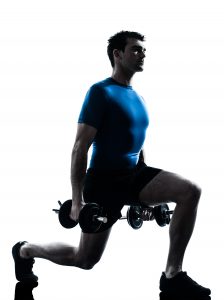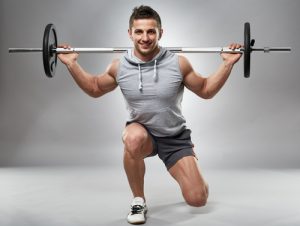If you’ve ever said the words “I don’t train my legs because I run/cycle/play football” then you’re missing out on some serious strength, physique and athletic benefits. All men should train their legs – as the largest muscle group in the body, there are a lot of secondary benefits to leg training that many people just don’t realise. With that in mind, here’s why all men should train their legs…
Leg Training Stimulates Growth Hormone Release
Human growth hormone has some remarkable properties. It is a stress hormone that is released by the muscle tissue when it is trained (stressed). The larger the muscles trained and the more frequently they are trained, the more human growth hormone is released.
As the largest muscle group in the body, the legs theoretically can provide you with the largest release of human growth hormone, as long as they are trained properly and frequently enough.
Human growth hormone helps to build lean body tissue (muscle) and at the same time reduce body fat. Its effect on muscle tissue and fat reduction are powerful enough that it has been banned by international sporting organisations as a performance-enhancing drug. Luckily for you, your body can produce it itself, as long as you train properly!
Frequent leg training will help you release more human growth hormone into your body than most other types of training.
Whole-Body Strength Benefits
Training your legs will make you stronger in other areas of the body. There are three main reasons for this, each with different explanations….
- Leg exercises typically use a lot of muscles, so there’s benefits across the board. Take squats for example – you may be targeting the legs, but you’ll also be recruiting the back and core muscle. This means those muscles will be strengthened too, giving you more training effect than you expected.
- There is a neural element to strength. When you train muscles, you don’t just change the muscle – you change the connective tissues and importantly, the nervous (neural) system. The neural system makes muscles work in the right sequencing and also ‘tells’ them when to contract etc. By improving the effectiveness of the neural system, you improve strength generally.
- Strong legs help in lots of lifts – they are key in all of the olympic weight lifting exercises and also exercises such as deadlifts, push presses, kettlebell swings and even powerlifting style bench presses. By training your legs, you’ll be a better overall athlete.
Leg Training Burns Lots of Calories
As a general rule, the harder the exercise and the more muscles it uses, the more calories it burns. The rule holds true for weight training – the bigger exercises such as squats, lunges and deadlifts will burn far more calories than exercises such as bicep curls and tricep pushdowns.
These large exercises will not only grow muscle and strength, but they’ll also burn a lot of fat – this will make you significantly leaner, showing off your hard work more than if you were growing muscle but keeping it hidden under a generous layer of body fat!
Training Legs Makes You More Injury Proof
If your reason for not training your legs is because you play football or run for example, you’re exposing yourself to more chance of injury. It sounds odd, but it’s true – here why…
All things being equal, strong muscles, bones and connective tissues (ligaments and tendons) are far more robust and less susceptible to injury than weaker muscles, bones and connective tissues. We strengthen those tissues by strength training, oddly enough!
With sports such as running and football, the likelihood of lower body injury is huge – most runners and footballers will experience a lower body injury at some point during their time doing the sport. With this in mind, if you can make your muscles, bones and connective tissues stronger by training your legs, you are far less susceptible to lower body injury.
Even if you think that training your legs will make you less able to run/play football/cycle, you should incorporate some lower body strength training into your weekly programme – you’ll improve your athletic performance (see the first and second points) and you’ll make yourself less injury-prone. Winning all round!
Exercises For Leg Training
The exercises I’ve linked to below will form the basis of a very effective leg training programme. To start with, even a couple of sets of each for 12-20 reps will be a significant shock to the body!
My suggestion is to start light, work on perfective technique with a higher volume. Once you have your technique down, then you can start to build strength by adding extra weight, sets and reps. Be careful, work hard but most importantly, work safely – the best programme in the world is useless if you can’t do it because of injury!
Why All Men Should Train Their Legs – Concluded
With strength, performance, physique and injury-reducing benefits from leg training, the case basically makes itself. Your leg training programme doesn’t have to complicated to be effective – incorporating basics such as squats, lunges, deadlifts and kettlebell swings would be enough to get you started. And remember that if you recently had a hair transplant surgery, you may need to give a break to your workouts.


